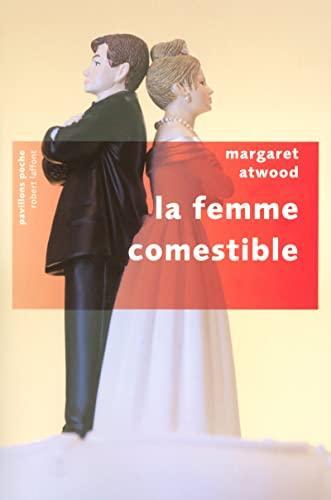French language
Published Nov. 28, 2008 by Éditions Robert Laffont.

French language
Published Nov. 28, 2008 by Éditions Robert Laffont.
The Edible Woman is the first novel by Margaret Atwood, published in 1969, which helped to establish Atwood as a prose writer of major significance. It is the story of a young woman, Marian, whose sane, structured, consumer-oriented world starts to slip out of focus. Following her engagement, Marian feels her body and her self are becoming separated. Marian begins endowing food with human qualities that cause her to identify with it, and finds herself unable to eat, repelled by metaphorical cannibalism. In a foreword written in 1979 for the Virago edition of the novel, Atwood described it as a protofeminist rather than feminist work.Atwood explores gender stereotypes through characters who strictly adhere to them (such as Peter or Lucy) and those who defy their constraints (such as Ainsley or Duncan). The narrative point of view shifts from first to third person, accentuating Marian's slow detachment from reality. At the …
The Edible Woman is the first novel by Margaret Atwood, published in 1969, which helped to establish Atwood as a prose writer of major significance. It is the story of a young woman, Marian, whose sane, structured, consumer-oriented world starts to slip out of focus. Following her engagement, Marian feels her body and her self are becoming separated. Marian begins endowing food with human qualities that cause her to identify with it, and finds herself unable to eat, repelled by metaphorical cannibalism. In a foreword written in 1979 for the Virago edition of the novel, Atwood described it as a protofeminist rather than feminist work.Atwood explores gender stereotypes through characters who strictly adhere to them (such as Peter or Lucy) and those who defy their constraints (such as Ainsley or Duncan). The narrative point of view shifts from first to third person, accentuating Marian's slow detachment from reality. At the conclusion, first person narration returns, consistent with the character's willingness to take control of her life again. Food and clothing are major symbols used by the author to explore themes and grant the reader insight on each of the characters' personalities, moods, and motivations. Setting is used to identify differences between the characters; for example, Duncan is encountered in a mundane laundromat, gloomy theatre or sleazy hotel. In comparison, Peter inhabits genteel bars and a sparkling new apartment. However these changing environments are also used to explore different angles of existence, contrasting a freer, wilder glimpse of life, with a civilised, gilded cage. This highlights the difficulties presented to women in the era, where freedom was synonymous with uncertainty but marriage presented problems of its own. This novel's publication coincided with the rise of the women's movement in North America, but is described by Atwood as "protofeminist" because it was written in 1965 and thus anticipated second-wave feminism.